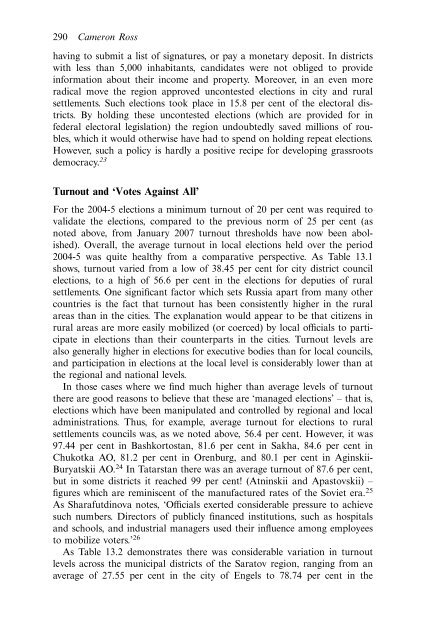Federalism and Local Politics in Russia
Federalism and Local Politics in Russia
Federalism and Local Politics in Russia
Create successful ePaper yourself
Turn your PDF publications into a flip-book with our unique Google optimized e-Paper software.
290 Cameron Rosshav<strong>in</strong>g to submit a list of signatures, or pay a monetary deposit. In districtswith less than 5,000 <strong>in</strong>habitants, c<strong>and</strong>idates were not obliged to provide<strong>in</strong>formation about their <strong>in</strong>come <strong>and</strong> property. Moreover, <strong>in</strong> an even moreradical move the region approved uncontested elections <strong>in</strong> city <strong>and</strong> ruralsettlements. Such elections took place <strong>in</strong> 15.8 per cent of the electoral districts.By hold<strong>in</strong>g these uncontested elections (which are provided for <strong>in</strong>federal electoral legislation) the region undoubtedly saved millions of roubles,which it would otherwise have had to spend on hold<strong>in</strong>g repeat elections.However, such a policy is hardly a positive recipe for develop<strong>in</strong>g grassrootsdemocracy. 23Turnout <strong>and</strong> ‘Votes Aga<strong>in</strong>st All’For the 2004-5 elections a m<strong>in</strong>imum turnout of 20 per cent was required tovalidate the elections, compared to the previous norm of 25 per cent (asnoted above, from January 2007 turnout thresholds have now been abolished).Overall, the average turnout <strong>in</strong> local elections held over the period2004-5 was quite healthy from a comparative perspective. As Table 13.1shows, turnout varied from a low of 38.45 per cent for city district councilelections, to a high of 56.6 per cent <strong>in</strong> the elections for deputies of ruralsettlements. One significant factor which sets <strong>Russia</strong> apart from many othercountries is the fact that turnout has been consistently higher <strong>in</strong> the ruralareas than <strong>in</strong> the cities. The explanation would appear to be that citizens <strong>in</strong>rural areas are more easily mobilized (or coerced) by local officials to participate<strong>in</strong> elections than their counterparts <strong>in</strong> the cities. Turnout levels arealso generally higher <strong>in</strong> elections for executive bodies than for local councils,<strong>and</strong> participation <strong>in</strong> elections at the local level is considerably lower than atthe regional <strong>and</strong> national levels.In those cases where we f<strong>in</strong>d much higher than average levels of turnoutthere are good reasons to believe that these are ‘managed elections’ –that is,elections which have been manipulated <strong>and</strong> controlled by regional <strong>and</strong> localadm<strong>in</strong>istrations. Thus, for example, average turnout for elections to ruralsettlements councils was, as we noted above, 56.4 per cent. However, it was97.44 per cent <strong>in</strong> Bashkortostan, 81.6 per cent <strong>in</strong> Sakha, 84.6 per cent <strong>in</strong>Chukotka AO, 81.2 per cent <strong>in</strong> Orenburg, <strong>and</strong> 80.1 per cent <strong>in</strong> Ag<strong>in</strong>skii-Buryatskii AO. 24 In Tatarstan there was an average turnout of 87.6 per cent,but <strong>in</strong> some districts it reached 99 per cent! (Atn<strong>in</strong>skii <strong>and</strong> Apastovskii) –figures which are rem<strong>in</strong>iscent of the manufactured rates of the Soviet era. 25As Sharafutd<strong>in</strong>ova notes, ‘Officials exerted considerable pressure to achievesuch numbers. Directors of publicly f<strong>in</strong>anced <strong>in</strong>stitutions, such as hospitals<strong>and</strong> schools, <strong>and</strong> <strong>in</strong>dustrial managers used their <strong>in</strong>fluence among employeesto mobilize voters.’ 26As Table 13.2 demonstrates there was considerable variation <strong>in</strong> turnoutlevels across the municipal districts of the Saratov region, rang<strong>in</strong>g from anaverage of 27.55 per cent <strong>in</strong> the city of Engels to 78.74 per cent <strong>in</strong> the
















